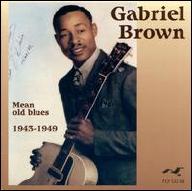The result was Brown's recording debut in a series of performances cut for the Library of Congress. Details of the man's life are a bit sketchy, gaps occurring in between these recordings and his arrival as a performer in New York City in the '40s as well as the period leading up to his death in Florida in the early '70s in a boating accident. As usual with blues artists, there are sometimes several variations on what might have happened, including him actually dying a decade earlier. Sometimes Hurston is the one who gets the credit with bringing Brown to the Big Apple to work in a light opera she'd written, but apparently the bluesman was already in the big city when he was enlisted to perform in +Polk County, Hurston's attempt at setting a musical comedy inside a turpentine camp. And by this time Brown already had a new relationship with a producer that would be even more important to his career than Hurston had been. That was Joe Davis, whose busy half a century in the record business included working as a songwriter, publisher, A&R man, record label owner, and record producer. He would continually record Brown for the next decade, searching for an elusive "hit" sound and sometimes sitting on as many as a dozen finished masters in the process.
Brown's background at the time he came to the attention of Hurston already stood in contrast to many self-educated earlier country blues performers. He was a graduate of the Florida Agricultural and Mechanical College, and also was said to have studied medicine. He began playing music on the Hawaiian guitar and singing with a group in this style known as the Sun to Sun Singers. By the time the Library of Congress caught up with him, though, he had transitioned to the regular acoustic guitar and was playing in a slide style, but one that really sounds very little like any other recorded bluesman. In 1934, Brown was invited to the National Folk Festival in St. Louis as a representative of the state of Florida and won first prize as both a folk singer and guitarist.
The following year he began a four year involvement with the Federal Arts Theatre, at that point under the direction of Welles. In the late '30s, he was a featured singer on the radio in Cincinnati in the wooly Sheep and Goats Club program, and also appeared in the show St. Louis Woman. In 1943, Brown wound up on U.S.O. shows and entered the civil service, working for a branch of the Army Signal Corps in Asbury Park, NJ. The same coastal club scene that would later be glorified by rocker Bruce Springsteen was a performing home for Brown in the '40s. The first recording session under the auspices of Davis took place in 1943, and the two would continue working together until 1952. A pattern emerged from these sessions involving the creation of a backlog of unreleased material, some of which was only heard by the blues audience following the reissue booms of the '70s and '80s.
At one point a few years before his own death, Davis had to take legal action to quash a bootleg reissue of the Brown sides that were in the can; eventually, legal collections of the bluesman came out on labels such as Flyright and Krazy Kat. The material that did get commercially issued during Brown's lifetime was not always chosen for artistic reasons, or promoted in any kind of tasteful or even accurate manner. Davis, ever mindful of the commercial potential of smutty material, was most enthusiastic about titles such as It's Getting Soft, promoted with postcards of a man leading a sexy lass into a motel room and urging her to "Hurry up honey, it's getting soft!" The fellow is also carrying a bucket of ice cream, of course. Meanwhile, more intelligent Brown performances languished in the can, but at least Davis had the foresight to continue scheduling recording sessions with the Florida bluesman. In the late '40s, some of these recordings were licensed to Coral, a subsidiary label of Decca. When Davis went to work as an A&R man for MGM, Brown was part of the roster of artists brought to the label. MGM not surprisingly tried to promote the blues singer as a kind of pop vocalist. The final sessions Davis cut with Brown in 1952 are considered some of his finest recordings, but were never even offered to MGM. ~ Eugene Chadbourne, Rovi













